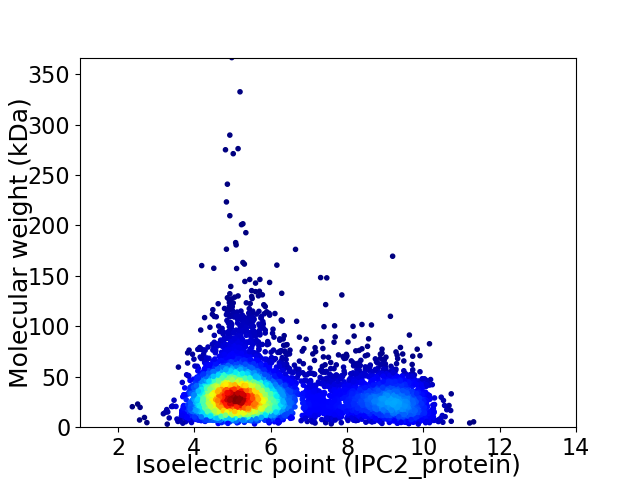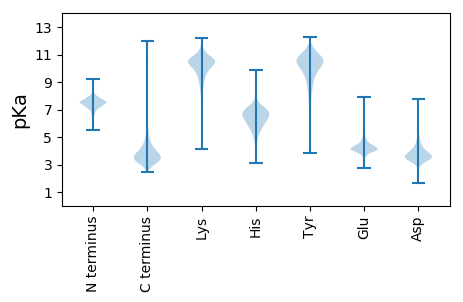
Stackebrandtia nassauensis (strain DSM 44728 / CIP 108903 / NRRL B-16338 / NBRC 102104 / LLR-40K-21)
Taxonomy: cellular organisms; Bacteria; Terrabacteria group; Actinobacteria; Actinomycetia; Glycomycetales; Glycomycetaceae; Stackebrandtia; Stackebrandtia nassauensis
Average proteome isoelectric point is 6.12
Get precalculated fractions of proteins

Virtual 2D-PAGE plot for 6379 proteins (isoelectric point calculated using IPC2_protein)
Get csv file with sequences according to given criteria:
* You can choose from 21 different methods for calculating isoelectric point
Summary statistics related to proteome-wise predictions



Protein with the lowest isoelectric point:
>tr|D3PWW4|D3PWW4_STANL Monooxygenase FAD-binding protein OS=Stackebrandtia nassauensis (strain DSM 44728 / CIP 108903 / NRRL B-16338 / NBRC 102104 / LLR-40K-21) OX=446470 GN=Snas_5557 PE=4 SV=1
MM1 pKa = 6.7TTHH4 pKa = 7.09HH5 pKa = 7.56DD6 pKa = 3.18IDD8 pKa = 3.46AHH10 pKa = 6.67YY11 pKa = 8.77DD12 pKa = 3.25TDD14 pKa = 5.13DD15 pKa = 3.98PVLLADD21 pKa = 4.49LMARR25 pKa = 11.84VDD27 pKa = 5.32DD28 pKa = 4.8LDD30 pKa = 3.66SHH32 pKa = 6.34QLADD36 pKa = 3.63YY37 pKa = 10.79AIGRR41 pKa = 11.84GLTPPGYY48 pKa = 10.8VPGHH52 pKa = 6.2YY53 pKa = 10.27YY54 pKa = 10.67SIDD57 pKa = 3.77LAWPPGADD65 pKa = 4.02DD66 pKa = 4.75GDD68 pKa = 4.73GVLLWSTSRR77 pKa = 11.84LGDD80 pKa = 3.77DD81 pKa = 4.37GVPADD86 pKa = 4.66EE87 pKa = 5.98DD88 pKa = 4.07DD89 pKa = 3.98AAVWDD94 pKa = 4.21SAQPP98 pKa = 3.41
MM1 pKa = 6.7TTHH4 pKa = 7.09HH5 pKa = 7.56DD6 pKa = 3.18IDD8 pKa = 3.46AHH10 pKa = 6.67YY11 pKa = 8.77DD12 pKa = 3.25TDD14 pKa = 5.13DD15 pKa = 3.98PVLLADD21 pKa = 4.49LMARR25 pKa = 11.84VDD27 pKa = 5.32DD28 pKa = 4.8LDD30 pKa = 3.66SHH32 pKa = 6.34QLADD36 pKa = 3.63YY37 pKa = 10.79AIGRR41 pKa = 11.84GLTPPGYY48 pKa = 10.8VPGHH52 pKa = 6.2YY53 pKa = 10.27YY54 pKa = 10.67SIDD57 pKa = 3.77LAWPPGADD65 pKa = 4.02DD66 pKa = 4.75GDD68 pKa = 4.73GVLLWSTSRR77 pKa = 11.84LGDD80 pKa = 3.77DD81 pKa = 4.37GVPADD86 pKa = 4.66EE87 pKa = 5.98DD88 pKa = 4.07DD89 pKa = 3.98AAVWDD94 pKa = 4.21SAQPP98 pKa = 3.41
Molecular weight: 10.58 kDa
Isoelectric point according different methods:
Protein with the highest isoelectric point:
>tr|D3Q5V1|D3Q5V1_STANL Transcriptional regulator LuxR family OS=Stackebrandtia nassauensis (strain DSM 44728 / CIP 108903 / NRRL B-16338 / NBRC 102104 / LLR-40K-21) OX=446470 GN=Snas_0536 PE=4 SV=1
MM1 pKa = 7.69SKK3 pKa = 9.0RR4 pKa = 11.84TFQPNNRR11 pKa = 11.84RR12 pKa = 11.84RR13 pKa = 11.84AKK15 pKa = 8.7THH17 pKa = 5.15GFRR20 pKa = 11.84LRR22 pKa = 11.84MRR24 pKa = 11.84TRR26 pKa = 11.84AGRR29 pKa = 11.84AIVAARR35 pKa = 11.84RR36 pKa = 11.84RR37 pKa = 11.84QGRR40 pKa = 11.84AKK42 pKa = 9.59LTAA45 pKa = 4.17
MM1 pKa = 7.69SKK3 pKa = 9.0RR4 pKa = 11.84TFQPNNRR11 pKa = 11.84RR12 pKa = 11.84RR13 pKa = 11.84AKK15 pKa = 8.7THH17 pKa = 5.15GFRR20 pKa = 11.84LRR22 pKa = 11.84MRR24 pKa = 11.84TRR26 pKa = 11.84AGRR29 pKa = 11.84AIVAARR35 pKa = 11.84RR36 pKa = 11.84RR37 pKa = 11.84QGRR40 pKa = 11.84AKK42 pKa = 9.59LTAA45 pKa = 4.17
Molecular weight: 5.31 kDa
Isoelectric point according different methods:
Peptides (in silico digests for buttom-up proteomics)
Below you can find in silico digests of the whole proteome with Trypsin, Chymotrypsin, Trypsin+LysC, LysN, ArgC proteases suitable for different mass spec machines.| Try ESI |
 |
|---|
| ChTry ESI |
 |
|---|
| ArgC ESI |
 |
|---|
| LysN ESI |
 |
|---|
| TryLysC ESI |
 |
|---|
| Try MALDI |
 |
|---|
| ChTry MALDI |
 |
|---|
| ArgC MALDI |
 |
|---|
| LysN MALDI |
 |
|---|
| TryLysC MALDI |
 |
|---|
| Try LTQ |
 |
|---|
| ChTry LTQ |
 |
|---|
| ArgC LTQ |
 |
|---|
| LysN LTQ |
 |
|---|
| TryLysC LTQ |
 |
|---|
| Try MSlow |
 |
|---|
| ChTry MSlow |
 |
|---|
| ArgC MSlow |
 |
|---|
| LysN MSlow |
 |
|---|
| TryLysC MSlow |
 |
|---|
| Try MShigh |
 |
|---|
| ChTry MShigh |
 |
|---|
| ArgC MShigh |
 |
|---|
| LysN MShigh |
 |
|---|
| TryLysC MShigh |
 |
|---|
General Statistics
Number of major isoforms |
Number of additional isoforms |
Number of all proteins |
Number of amino acids |
Min. Seq. Length |
Max. Seq. Length |
Avg. Seq. Length |
Avg. Mol. Weight |
|---|---|---|---|---|---|---|---|
0 |
2067818 |
30 |
3291 |
324.2 |
34.93 |
Amino acid frequency
Ala |
Cys |
Asp |
Glu |
Phe |
Gly |
His |
Ile |
Lys |
Leu |
|---|---|---|---|---|---|---|---|---|---|
12.671 ± 0.041 | 0.801 ± 0.008 |
6.652 ± 0.03 | 5.691 ± 0.026 |
2.965 ± 0.018 | 8.794 ± 0.032 |
2.206 ± 0.016 | 3.969 ± 0.018 |
2.68 ± 0.03 | 10.069 ± 0.04 |
Met |
Asn |
Gln |
Pro |
Arg |
Ser |
Thr |
Val |
Trp |
Tyr |
|---|---|---|---|---|---|---|---|---|---|
1.927 ± 0.014 | 2.188 ± 0.015 |
5.621 ± 0.027 | 2.643 ± 0.015 |
7.343 ± 0.034 | 5.468 ± 0.023 |
6.261 ± 0.024 | 8.309 ± 0.025 |
1.576 ± 0.013 | 2.166 ± 0.014 |
Most of the basic statistics you can see at this page can be downloaded from this CSV file
Proteome-pI is available under Creative Commons Attribution-NoDerivs license, for more details see here
| Reference: Kozlowski LP. Proteome-pI 2.0: Proteome Isoelectric Point Database Update. Nucleic Acids Res. 2021, doi: 10.1093/nar/gkab944 | Contact: Lukasz P. Kozlowski |
